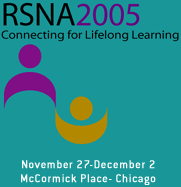
Abstract Archives of the RSNA, 2005
SSQ08-09
Automated Liver Segmentation and Volume Calculation from MDCT Data Sets Using a Dual-clustering Technique: Comparison with Planimetry
Scientific Papers
Presented on December 1, 2005
Presented as part of SSQ08: Gastrointestinal (Liver: Focal LesionsóCT)
Orlando Alberto Castillo MD, Presenter: Nothing to Disclose
Kristen Keriakos, Abstract Co-Author: Nothing to Disclose
James F. Stinchon MD, Abstract Co-Author: Nothing to Disclose
Hernan Jara PhD, Abstract Co-Author: Nothing to Disclose
Jorge Andres Soto MD, Abstract Co-Author: Nothing to Disclose
In this study we compared the accuracy of a highly automated method for calculating liver volume using MDCT data sets vs. a manual tracing (planimetry) technique.
MDCT data sets from 14 adult patients were included in this IRB-approved study. All scans were acquired in a 16-channel detector scanner (Lightspeed, GE Medical Systems, Milwaukee, Wis), with 2.5 mm slice thickness and a radiation modulation system. Data was transferred to PC-Windows workstations for automated volume calculations. The segmentation algorithm is based on dual-space clustering and morphological dilation and was developed in Mathcad version 2001i. For the planimetry technique, a radiologist traced the boundaries of the liver on every CT image and organ volume was then calculated accounting for voxel size. Time required for segmentation using both techniques was recorded and volumes obtained with both techniques were compared using linear regression analysis.
Mean calculated liver volume was 1657 mL (range, 1318 to 2101 mL) using the planimetry technique and 1691 mL (range, 1246 to 2172 mL) using the automated technique. As compared to planimetry, the automated technique overestimated liver size in 6 patients and underestimated it in 8 patients. Mean difference in calculated liver volumes between both techniques was 5.6% (range, 0.1 to 17.7%). Mean segmentation time was 7 minutes for the automated method and 40 minutes for the manual tracing technique. The calculated correlation coefficient was .66 for liver volume.
The automated technique described provides an accurate and time-efficient method for calculation of liver volume. The accuracy of the automated technique is comparable to that of a manual tracing system.
Castillo, O,
Keriakos, K,
Stinchon, J,
Jara, H,
Soto, J,
Automated Liver Segmentation and Volume Calculation from MDCT Data Sets Using a Dual-clustering Technique: Comparison with Planimetry. Radiological Society of North America 2005 Scientific Assembly and Annual Meeting, November 27 - December 2, 2005 ,Chicago IL.
http://archive.rsna.org/2005/4415103.html

